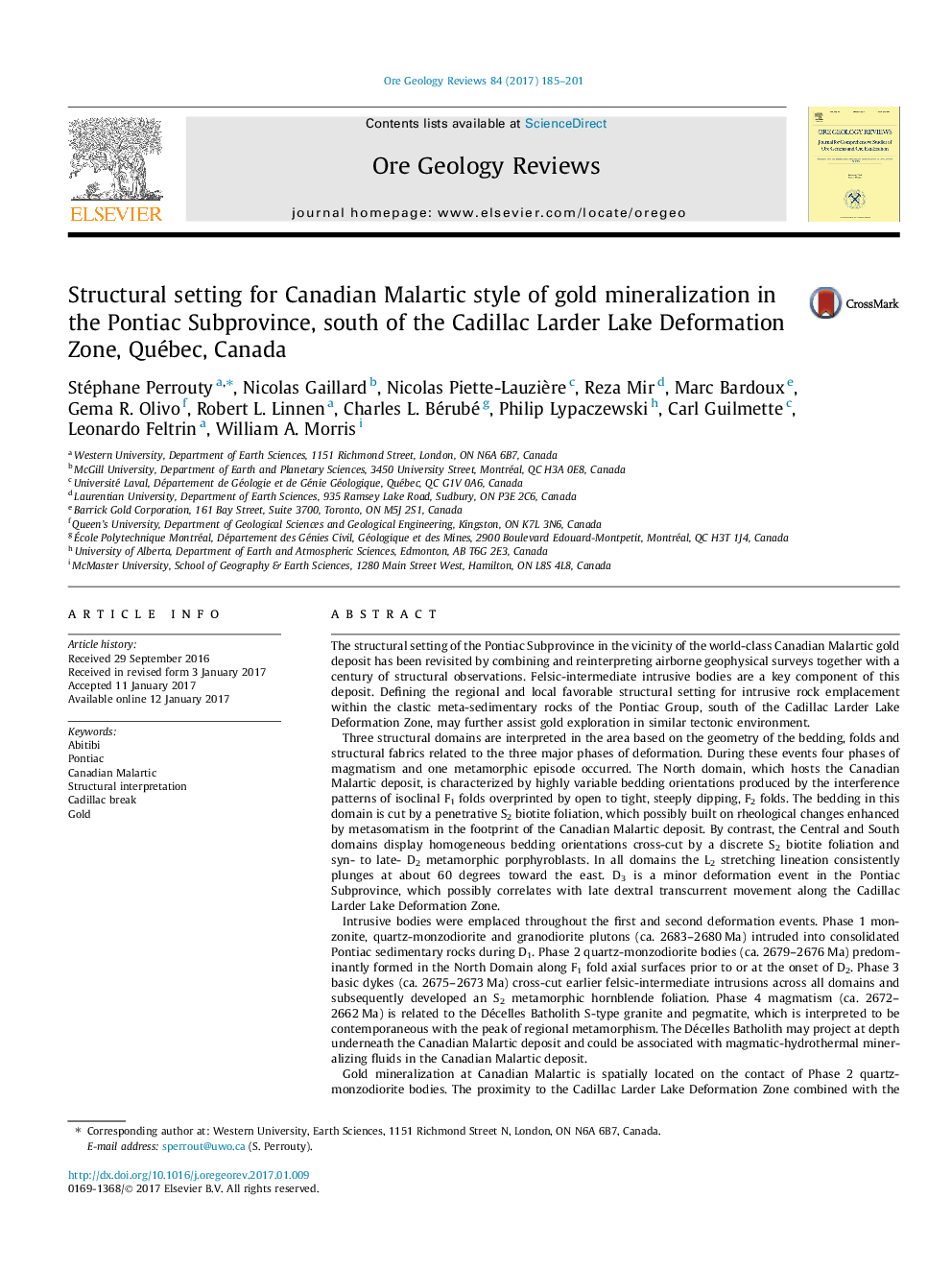| کد مقاله | کد نشریه | سال انتشار | مقاله انگلیسی | نسخه تمام متن |
|---|---|---|---|---|
| 5782464 | 1637223 | 2017 | 17 صفحه PDF | دانلود رایگان |

- Quartz-monzodiorite bodies were emplaced during D2 within F1 fold hinges.
- They are rheologically related with gold mineralization at Canadian Malartic.
- The variance of the bedding dip is used to map structurally complex zones.
- High intensity of the S2 foliation is a potential marker of the metasomatized area.
- Our methodology can be used as prospectivity criteria to explore in similar terranes.
The structural setting of the Pontiac Subprovince in the vicinity of the world-class Canadian Malartic gold deposit has been revisited by combining and reinterpreting airborne geophysical surveys together with a century of structural observations. Felsic-intermediate intrusive bodies are a key component of this deposit. Defining the regional and local favorable structural setting for intrusive rock emplacement within the clastic meta-sedimentary rocks of the Pontiac Group, south of the Cadillac Larder Lake Deformation Zone, may further assist gold exploration in similar tectonic environment.Three structural domains are interpreted in the area based on the geometry of the bedding, folds and structural fabrics related to the three major phases of deformation. During these events four phases of magmatism and one metamorphic episode occurred. The North domain, which hosts the Canadian Malartic deposit, is characterized by highly variable bedding orientations produced by the interference patterns of isoclinal F1 folds overprinted by open to tight, steeply dipping, F2 folds. The bedding in this domain is cut by a penetrative S2 biotite foliation, which possibly built on rheological changes enhanced by metasomatism in the footprint of the Canadian Malartic deposit. By contrast, the Central and South domains display homogeneous bedding orientations cross-cut by a discrete S2 biotite foliation and syn- to late- D2 metamorphic porphyroblasts. In all domains the L2 stretching lineation consistently plunges at about 60 degrees toward the east. D3 is a minor deformation event in the Pontiac Subprovince, which possibly correlates with late dextral transcurrent movement along the Cadillac Larder Lake Deformation Zone.Intrusive bodies were emplaced throughout the first and second deformation events. Phase 1 monzonite, quartz-monzodiorite and granodiorite plutons (ca. 2683-2680Â Ma) intruded into consolidated Pontiac sedimentary rocks during D1. Phase 2 quartz-monzodiorite bodies (ca. 2679-2676Â Ma) predominantly formed in the North Domain along F1 fold axial surfaces prior to or at the onset of D2. Phase 3 basic dykes (ca. 2675-2673Â Ma) cross-cut earlier felsic-intermediate intrusions across all domains and subsequently developed an S2 metamorphic hornblende foliation. Phase 4 magmatism (ca. 2672-2662Â Ma) is related to the Décelles Batholith S-type granite and pegmatite, which is interpreted to be contemporaneous with the peak of regional metamorphism. The Décelles Batholith may project at depth underneath the Canadian Malartic deposit and could be associated with magmatic-hydrothermal mineralizing fluids in the Canadian Malartic deposit.Gold mineralization at Canadian Malartic is spatially located on the contact of Phase 2 quartz-monzodiorite bodies. The proximity to the Cadillac Larder Lake Deformation Zone combined with the rheological contrast between steeply dipping clastic meta-sedimentary rocks and quartz-monzodiorite intrusions favored the protracted failure of the contacts between these two rock masses, thus forming favorable conduits for hydrothermal fluids (e.g., the Sladen Fault Zone). Such specific rheological behavior is demonstrated by domains of structural complexity, emphasized by the variance of the bedding dip. These structurally complex zones systematically host gold mineralization in the Canadian Malartic district of the Pontiac Subprovince proximal to the Cadillac Larder Lake Deformation Zone.
165
Journal: Ore Geology Reviews - Volume 84, April 2017, Pages 185-201